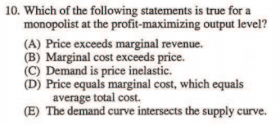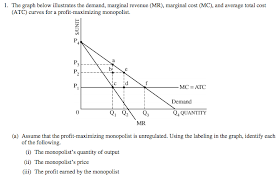Monopoly 6 Consumer/Producer Surplus & DWL
Consumer/Producer Surplus
Notice that where Allocative efficiency occurs Consumer Surplus and Producer surplus is maximized.
2008 AP Microeconomics Exam
Answer (D)
As we know that Profit max is a higher price and a lower output,, and allocative efficient level has a lower price (good for consumers) and more output (good for consumers), then we know that consumer surplus has increased. Think of this problem by focusing on what has changed.
2008B AP Microeconomics Exam FRQ, Q1
2006 AP Microeconomics Exam FRQ, Q1
Look at (iii) The museum maximizes the consumer/producer surplus.
Notice that where Allocative efficiency occurs Consumer Surplus and Producer surplus is maximized.
Answer (P4, Q3), where P=MC
DWL (Dead Weight Loss)
Remember that a monopoly is a form of market failure, thus it has DWL.
Welfare Loss, or dead weight loss - refers to decreases in producer and/or consumer surplus as a result of either more or less than the socially optimal level of output produced and consumed.
2003 AP Microeconomics Exam FRQ, Q2
Look at (C)(ii) Deadweight loss



































